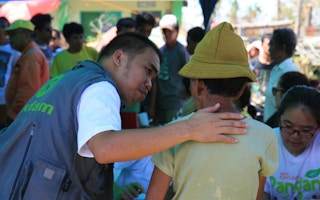The Intergovernmental Panel on Climate Change released the second part of its Fifth Assessment Report (AR5) last week, and at the risk of sounding alarmist, the future looks bleak, particularly for the Philippines.
To continue reading, subscribe to Eco‑Business.
There's something for everyone. We offer a range of subscription plans.
- Access our stories and receive our Insights Weekly newsletter with the free EB Member plan.
- Unlock unlimited access to our content and archive with EB Circle.
- Publish your content with EB Premium.
The archipelagic nation is at the frontline of the fight against climate change, and the world only needs to look back a few months ago to see how Super Typhoon Haiyan decimated the central region, leaving over 6,000 dead and countless people without homes or livelihoods.
It is this bleak outlook for the Philippines that led two international organisations - namely, Greenpeace and Oxfam - and Aksyon Klima Pilipinas, a local network of 40 climate change-oriented civil society organisations to convene on Friday to discuss the implications of the IPCC AR5 Working Group II report on the Philippines.
The participants also urged the national government to disburse the 500 million peso that it committed for the People’s Survival Fund (PSF), the budget intended to finance adaptation plans of local government units.
This measly amount is only half of the one billion pesos mandated by law per year, said the representatives from the three organisations. Now compare that to the estimated $36 billion worth of damages caused by Haiyan (referred to locally as Yolanda). Using current exchange rates and simple arithmetic, the fund that will supposedly allow the country to adapt to climate change is only 0.03 per cent of the losses already incurred in one incident in one year in one region.
“
The Philippines is known for famously toppling the Marcos dictatorship with a bloodless people power revolution, and this kind of mass movement could be the means to drive the urgent action required to reduce emissions in the atmosphere.
Indeed, even though climate scientists may not categorically say that climate change is responsible for extreme weather events, IPCC AR5 co-author Lourdes Tibig pointed out how Haiyan is an example of a climate-related extreme weather event, just like droughts and heat waves, which are part of widespread impacts observed by the IPCC.
Tibig, one of only five Filipinos in the over 700 international authors and review editors who wrote the report, entitled “Climate Change 2014: Impacts, Adaptation and Vulnerability”, stressed the finding that recent climate-related extremes reveal “significant vulnerability and exposure of some ecosystems and many human systems to current climate variability”.
The panel expressed “very high confidence”, in academic jargon, that the systems that people depend on, such as food production, water supply and infrastructure, are susceptible to disruption or damage. These impacts are also consistent with a “significant lack of preparedness” by vulnerable communities, noted the report.
But how can the Philippines adequately prepare when it lacks financial resources to adapt?
“Money alone will not solve climate change”, admitted Amalie Obusan, regional climate and energy campaigner of Greenpeace Southeast Asia. “But it is needed for adaptation and mitigation”, she said at the press conference.
The meagre financial resources allocated to climate adaptation are in stark contrast to the funds disbursed through the country’s Priority Development Assistance Fund (PDAF), which hogged national headlines prior to Typhoon Haiyan after some Philippine lawmakers were exposed to have allgedly stolen 10 billion pesos through the scheme.
When the two sums of money are compared, it becomes clear how this could have been better chanelled to fund 10 years’ worth of adaptation projects. These include Oxfam’s ‘climate resilience school’, which teaches farmers in Mindanao how to improve their farming against floods, or projects building the technical capacity of provincial governments to understand local climate scenarios to prepare better action plans. The latter, Tubig explained, is badly needed.
Sadly, the misappropriated PDAF money is squandered and another super typhoon might hit the country before the funds are recovered.
The IPCC report, despite the dire circumstances it detailed, did provide a gleam of hope - adaptation is increasing with “high confidence” across regions in the pubic and private sector and within communities.
The Philippines was even named among select places worldwide that exemplified community-based adaptation practices. For example, the local government in Albay province has been noted for mainstreaming climate change into local development policies by assisting farmers and fisher folk with their agricultural needs.
Similarly, Greenpeace, Aksyon Klima and Oxfam shared some of their on-the-ground projects, which aimed to educate and empower communities. These projects strengthened the capacity of communities to adapt to climate cange by localising climate science jargon and mapping vulnerabilities, amongst other strategies.
Actions such as these provide a sense of hope amidst the pessimistic sentiment surrounding climate change.
These ground-up efforts seem to be faring better than government-led action to tackle climate change - at least in the case of the Philiipines.
While I do agree that we need national policies or other top-down approaches to complement community-based adaptation, as proposed by the IPCC, I am inclined to favour with the bottoms-up approach over waiting for any government-led large-scale transformation.
The Philippines is known for famously toppling the Marcos dictatorship with a bloodless people power revolution, and this kind of mass movement could be the means to drive the urgent action required to reduce emissions in the atmosphere.
We need more initiatives like those implemented in Albay or by Oxfam and other organisations to collectively propel a change in human systems, from making food production sustainable to ensuring infrastructure is disaster-proof.
The country cannot solely wait for President Aquino to move the PSF forward, though Aksyon Klima and others demand it. Similarly, the rest of the world cannot wait for climate negotiations to bear fruit when even Yeb Saño, climate change commissioner of the Philippines, previously said “that despite the significant gains we have had since the [United Nations Framework Convention on Climate Change] was born, 20 years hence we continue to fail in fulfilling the ultimate objective of the Convention.”
To make matters worse, although the President has declared that the country must transition to a renewable energy future, he still approved 17 new coal plant projects, noted Voltaire Alferez, Aksyon Klima Pilipinas national coordinator.
Alferez called on the President Aquino to become the nation’s climate champion, especially since he is the chair of the Climate Change Commission. But with 17 coal plants under his belt and not to mention an apology four months too late to Haiyan victims for the government’s slow response, this might be a pipe dream.
Ironic though how with a name like People’s Survival Fund, there is no urgency for that survival.











